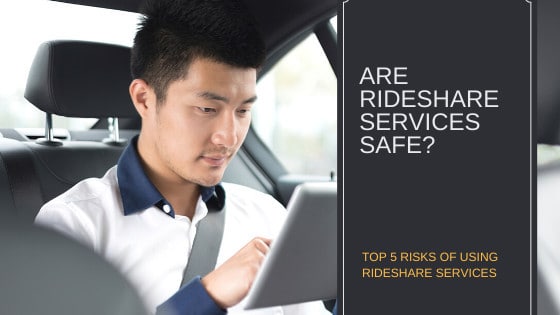
Rideshare services are not as safe as you think. There are multiple considerations to take into account when weighing up the risk of rideshare services versus taxis, or private transportation and secure transportation services. The variables are numerous and include country, city, and location of use, time of day, destination, reason, and who you are to name a few.
Here are the Top 5 risks to take into account when considering the use of rideshare services:
Top 5 Risks of Using Rideshare services
- Risk of Assault
Companies like Uber and Lyft have claimed all their drivers go through some level of security checks before they can operate on the ground. However, this does not necessarily mean they are genuine or trustworthy, nor does it demonstrate how competent they are behind the wheel. For example, a male driver from Washington, who worked for both Uber and Lyft, reportedly committed at least five sexual assaults, including rape, against females since 2014 while on duty. His most current attack was in March 2019 and has subsequently been arrested.
- Fake drivers
Fake drivers are another concerning problem for the rideshare community. In March 2019, a female student from North Carolina was kidnapped and murdered after she boarded a vehicle, she believed was her Uber. This is not an isolated incident and is an increasing concern on a global scale. Implementing logical mitigation measures will help to reduce the risks.
For example, checking the vehicle’s make, model and registration, make sure the driver’s name and/or photo matches your records and ensure your driver has your correct details before getting into their vehicle. Unfortunately, it’s not possible to completely mitigate the risks. Boarding a stranger’s vehicle will most likely put you in a vulnerable position, remaining vigilant is crucial.
- Road Traffic Crashes
Road Traffic Crashes (RTC) are identified as the number one cause of death for travelers worldwide and it’s becoming a global health concern. The vast majority of Rideshare drivers are part-time drivers, not professional, nor trained. The majority just jump in the car on their way home from work and do a few extra hours to supplement income. This also significantly increases the risk of fatigued driving, which is a major risk factor and a cause of multiple accidents.
- Insurance Coverage Ambiguity
An organization sending employees, students, or volunteers abroad has a legal and moral duty of care for their personal safety. Transporting employees through ridesharing companies and/or unregulated taxis increases the level of risk for the employees, and heightens the corporate liability of employers. There is also no specified insurance coverages, and if something goes wrong the user can only file against the driver who will likely not be covered to provide transportation services.
- Over-reliance on the App
A rideshare driver, for the majority, is not a full-time professional chauffeur and is generally reliant on an App to move from location to location. They follow the guidance from the App blindly. This may be ok in some cities. But as soon as you move into more challenging or dangerous environments one wrong turn or one ‘shortcut’ provided by Waze could lead the vehicle (and therefore the user) into a high-risk environment. Imagine taking a wrong turn in Rio de Janeiro and ending up in a favela. Or, taking a shortcut through a Mexico City suburb.
Duty of Care Considerations: Organization vs Private User:
As a private user of rideshare services, there are multiple things you can do to help improve travel safety. Click here to read our article on how to increase your safety when using rideshare services.
An organization should have robust journey management and overland transportation plan for its travelers. The moral and legal duty of care that is placed on an organization increases the risk of litigation if an incident occurs, but more importantly (we think) is that if the basics are not carried out, and cost is put before security, then travelers are placed at increased risk, which can be mitigated significantly with the right precautions in place.
- Assess the destination and understand the specific risk of that location.
- Empower your travelers by teaching them how to stay safe, increase situational awareness, and react appropriately if an incident occurs. Consider a travel security training course such as ExploreSecure®
- Use a secure transportation service that has enhanced vetting of drivers, local drivers with all licensing and checks, and appropriate and secure vehicles.
- Liaise with a security company for any travel to regions considered challenging or of increased risk. Seek consultation from subject matter experts as to the risks, and how to manage them. Contact Us






